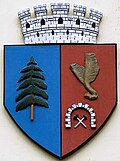Brad (Hunedoara)
|
Brad Tannenhof Brád |
||||
|
||||
| Basic data | ||||
|---|---|---|---|---|
| State : |
|
|||
| Historical region : | Transylvania | |||
| Circle : | Hunedoara | |||
| Coordinates : | 46 ° 8 ' N , 22 ° 47' E | |||
| Time zone : | EET ( UTC +2) | |||
| Height : | 278 m | |||
| Area : | 79.98 km² | |||
| Residents : | 14,495 (October 20, 2011) | |||
| Population density : | 181 inhabitants per km² | |||
| Postal code : | 335200 | |||
| Telephone code : | (+40) 02 54 | |||
| License plate : | HD | |||
| Structure and administration (as of 2016) | ||||
| Community type : | Municipality | |||
| Structure : | 5 districts / cadastral communities: Mesteacăn , Potingani , Ruda-Brad , Țărățel , Valea Bradului | |||
| Mayor : | Florin Cazacu ( PSD ) | |||
| Postal address : | St. Republicii, no. 18 loc. Brad, jud. Hunedoara, RO-335200 |
|||
| Website : | ||||
Brad ( German Tannenhof , Hungarian Brád ) is a small town in the Hunedoara district ( Romania ). The name comes from the Romanian word brad , which means “ fir ”.
location
Brad is located in a valley ( Depresiunea Brad ) named after the city on the upper reaches of the Crișul Alb ( White Screech ) river, between the Bihor Mountains in the north and the Transylvanian Ore Mountains in the south. The district capital Deva is 36 km south.
history
Mining has been practiced in the region of today's city for a long time, particularly gold. The oldest archaeological finds come from the Stone and Bronze Ages . Miners' settlements are documented from the period of domination of the Roman Empire . Brad was first mentioned in 1445; around 1600 it was a local administrative center. In 1784, the peasant uprising under Horea, Cloşca and Crişan began here. In 1848 Brad was one of the centers of the Romanian revolutionaries under Avram Iancu .
Until 1918 Brad belonged to the Kingdom of Hungary , under Ottoman rule to the Principality of Transylvania and Austria-Hungary . After the First World War , the place - like all of Transylvania - became part of Romania.
From 1927 to 1930, and definitely since 1941, Brad had or still has city status. In 1995 this was raised to the rank of municipality .
Brad isn't an industrial town since gold mining came to a standstill; There is a Dutch woodworking company and otherwise only good air in Brad.
population
In 1785 Brad had 1,499 residents. In 1850 4031 inhabitants were registered in the place, among them 3809 Romanians and 143 Roma . In 1992 the highest population was determined with 18,861. At the 2002 census, 16,482 people lived in Brad, of which around 14,000 were in the city proper and around 2,500 in the five cadastral parishes. 16,021 were Romanians, 226 Hungarians , 154 Roma, 54 Germans and 27 others.
traffic
Brad is the end of a railway line from Arad , on which about five pairs of trains run daily. The continuation of the line towards Deva is dismantled starting from Brad. The European road from Oradea to Thessaloniki runs through the city . From here the national road 74 branches off to Alba Iulia in Brad . There are regular bus connections especially to Deva.
Attractions
- "Gold Museum"
- Ethnographic Museum
- Station building (1896, historical monument)
Personalities
- Teodor Meleșcanu (* 1941), Romanian politician, former foreign, justice and defense minister
gallery
Web links
Individual evidence
- ↑ 2011 census in Romania at citypopulation.de
- ↑ a b website of the city (accessed December 14, 2008)
- ^ Censuses in Transylvania 1850–2002 (ung.)
- ^ Teodor Viorel Meleșcanu on the website of the Romanian House of Representatives







